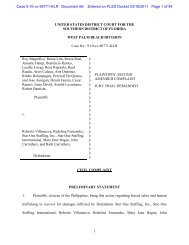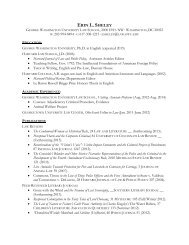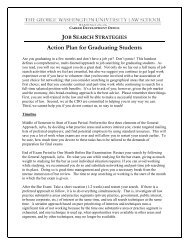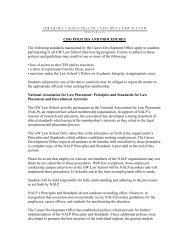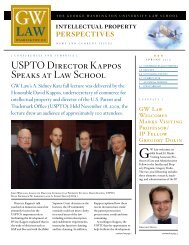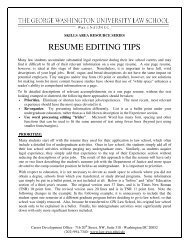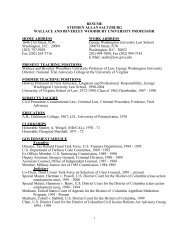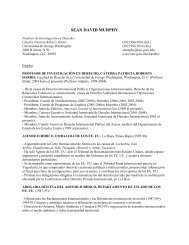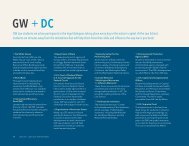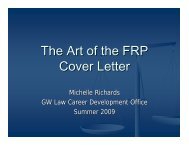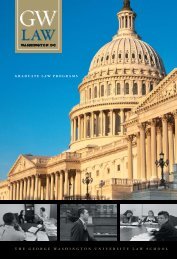Beluga Whale Import Permit Comment - George Washington ...
Beluga Whale Import Permit Comment - George Washington ...
Beluga Whale Import Permit Comment - George Washington ...
You also want an ePaper? Increase the reach of your titles
YUMPU automatically turns print PDFs into web optimized ePapers that Google loves.
COMMENT<br />
On Application of Georgia Aquarium, Inc.<br />
for a <strong>Permit</strong> to <strong>Import</strong> <strong>Beluga</strong> <strong>Whale</strong>s for Public Display<br />
under the Marine Mammal Protection Act<br />
and<br />
Draft Environmental Assessment<br />
for Issuance of <strong>Permit</strong> No. 17324<br />
for the <strong>Import</strong>ation of <strong>Beluga</strong> <strong>Whale</strong>s for Public Display Purposes<br />
October 29, 2012<br />
Before the<br />
National Marine Fisheries Service,<br />
National Oceanic and Atmospheric Administration,<br />
U.S. Department of Commerce<br />
Prepared by:<br />
Joan Schaffner, Esq., Erin Sheley, Esq.,<br />
Tyler Sniff, Jessica Kabaz-Gomez, Ann Porter, Emily Tone
Introduction<br />
The <strong>George</strong> <strong>Washington</strong> University Law School Animal Welfare Project (“GW Law<br />
AWP”) respectfully submits this comment to the National Marine Fisheries Services (“NMFS”)<br />
of the National Oceanic and Atmospheric Administration (“NOAA”) on a pending application by<br />
Georgia Aquarium, Inc. for a permit to import eighteen beluga for the purposes of public display<br />
under the Marine Mammal Protection Act (“MMPA”), 16 U.S.C. § 1361 et seq., and the<br />
associated Draft Environmental Assessment (“Draft EA”). These beluga whales are presently<br />
being held at the Utrish Marine Mammal Research Station on the Russian coast of the Black Sea.<br />
GW Law AWP is an independent pro bono effort of law faculty and law students that seeks to<br />
raise awareness of animal welfare issues and promote the interests of animals through the law.<br />
In this comment, GW Law AWP urges NMFS to deny the Georgia Aquarium’s<br />
application for a MMPA import permit. NMFS should not issue the Georgia Aquarium a<br />
MMPA import permit because the inability of the Aquarium and its partner facilities to<br />
successfully breed and sustain beluga whales indicates a lack of sufficient expertise and<br />
resources, as well as inadequate facilities, to achieve the captive breeding goals stated in the<br />
application, a criterion of permit issuance under 50 C.F.R. § 216.34. Alternatively, if NMFS<br />
approves the application, it should place restrictions on the permit that will protect the welfare of<br />
the imported beluga whales and ensure that the purposes of the import and the MMPA are<br />
satisfied over the long term. Specifically, the permit should require the Georgia Aquarium to<br />
conduct research on the impacts of captivity on beluga whales and other avenues of beluga whale<br />
repopulation, the submission of an annual report to NMFS on the condition of the imported<br />
beluga whales, as well as prohibit the sale of the imported beluga whales to facilities that will use<br />
them for purposes other than conservation.<br />
1
Prior to making any final decision on the Georgia Aquarium permit application, however,<br />
NMFS must improve its analysis of the environmental impacts of the agency’s action under the<br />
National Environmental Policy Act (“NEPA”), 42 U.S.C. § 4321 et seq. Under NEPA, an<br />
environmental assessment (“EA”), which NMFS has completed a draft of, was clearly required<br />
for this action, and thus all representations by the Agency in the Draft EA that a categorical<br />
exclusion (“CE”) would have been sufficient NEPA analysis are misleading and should not be<br />
included in the final EA. More importantly, the Draft EA is legally inadequate because it fails to<br />
consider reasonable alternatives within the jurisdiction of NMFS, including authorizing the<br />
import permit from a closer facility, allowing import of frozen beluga whale sperm for artificial<br />
insemination, instead of whales, and requiring the import of fewer whales along with sperm.<br />
NMFS should analyze these alternatives in any Final EA as it considers whether to deny the<br />
import application or impose reasonable restrictions on it.<br />
I. NMFS Should Not Issue the Georgia Aquarium an MMPA <strong>Import</strong> <strong>Permit</strong> Because<br />
the Inability of the Georgia Aquarium and Its Partner Facilities to Successfully<br />
Breed and Sustain <strong>Beluga</strong> <strong>Whale</strong>s Indicates a Lack of Sufficient Expertise and<br />
Resources, as well as Inadequate Facilities, to Achieve the Captive Breeding Goals<br />
Stated in the Application, a Criterion of <strong>Permit</strong> Issuance under 50 C.F.R. § 216.34.<br />
The Georgia Aquarium fails to meet the MMPA import permit issuance criteria set forth<br />
in 50 C.F.R. § 216.34. Under § 216.34, one criterion of permit issuance is “whether the<br />
applicant’s expertise, facilities, and resources are adequate to accomplish successfully the<br />
objectives and activities stated in the application.” According to the permit application, the<br />
purpose of the import “is to promote conservation and education and to enhance the North<br />
American beluga breeding cooperative by increasing the population base of captive beluga<br />
2
whales to a self-sustaining level.” 1 However, there is strong evidence indicating that the Georgia<br />
Aquarium and its partner facilities where it proposes to maintain the imported beluga whales lack<br />
the requisite expertise and resources to successfully conserve the beluga species and/or<br />
contribute to a self-sustaining captive population.<br />
None of the aquarium facilities named in the permit application has a successful history<br />
of breeding or maintaining beluga whales in their care. Since 1999, a mere eighteen beluga<br />
births have occurred between the Georgia Aquarium, Shedd Aquarium, Mystic Aquarium, and<br />
the three Sea World parks listed in the application (Orlando, San Antonio, and San Diego). 2 The<br />
Georgia Aquarium, in particular, has struggled to breed beluga whales, as evidenced by the May<br />
2012 death of its first captive-born calf, which died at just five days old. 3 The Shedd Aquarium<br />
has encountered similar difficulties, with only fifty percent of its captive-born beluga whales<br />
surviving to reach one year of age. Since 1999, the Shedd Aquarium’s program has produced ten<br />
beluga births, of which two were stillborn, and two calves died at less than two days old.<br />
Additionally, one of the remaining six calves surviving past infancy died at approximately one<br />
year of age. To date, the Mystic Aquarium has not produced any beluga calves. 4<br />
Likewise, the three Sea World parks named in the permit application have failed to<br />
demonstrate expertise sufficient to increase the North American captive beluga whale population<br />
to a self-sustaining level. Despite their relatively large collection of beluga whales, Sea World<br />
Orlando has reported only one beluga birth since 1999. Sea World San Antonio has been most<br />
1 Georgia Aquarium, Inc., Application for a <strong>Permit</strong> to <strong>Import</strong> Certain Marine Mammals for Public Display Under the<br />
Marine Mammal Protection Act, at 12 (June 15, 2012),<br />
http://www.nmfs.noaa.gov/pr/permits/sci_res_pdfs/17324_final_application.pdf [hereinafter application].<br />
2 See LUGA’LOGUE (last visited Sept. 27, 2012), http://www.ceta-base.com/lugalogue/.<br />
3 Georgia Aquarium’s Baby <strong>Beluga</strong> Dies Days After Critical Birth, WSBTV (May 23, 2012),<br />
http://www.wsbtv.com/news/news/local/baby-beluga-dies-days-after-critical-birth/nPCg9/.<br />
4 See LUGA’LOGUE, supra note 2.<br />
3
successful—with four calves born to three different mothers since the year 2000. 5 Most recently,<br />
in 2010, following the 2008 death of its first captive-born beluga whale calf, Sea World San<br />
Diego had one successful beluga whale birth. However, the mother subsequently ignored her<br />
calf, a phenomenon uncommon in wild beluga whale populations, and Sea World employees had<br />
to intervene to sustain the calf. 6 Additionally, all of these captive birthing patterns demonstrate a<br />
stark departure from the natural birthing patterns of wild beluga whales, where mothers give<br />
birth every two to three years on average. 7<br />
In addition to the failure of their captive breeding programs, the six marine mammal<br />
parks that would care for the imported beluga whales also have poor track records in sustaining<br />
adult beluga whales. In September of 1991, two young, wild-born beluga whales imported to the<br />
park the month prior died suddenly. The reported cause of death was acute cardiovascular<br />
collapse, although the precise cause was unknown. Similarly, the Orlando, San Antonio, and<br />
San Diego Sea World facilities have a history of deaths of young captive-born beluga whales,<br />
many transferred from other facilities. In 2003, Sea World Orlando reported the death of a four<br />
year-old captive-born beluga from intestinal torsion. Sea World San Antonio has reported four<br />
deaths of young beluga whales at its facilities since 1995, with three of the four beluga whales<br />
less than three years of age. Although one cause of death was undeterminable, the remaining<br />
causes included chronic osteomyelitis, acute cranial and cervical conditions, and acute bacterial<br />
pneumonia. 8 According to the Merck Veterinary Manual, cases of pneumonia arising in captive<br />
marine mammals “often can be considered the result of mismanagement,” since primary<br />
5<br />
MARINE MAMMAL INVENTORY REPORT: SEA WORLD, LLC 1–3 (June 7, 2011), available at http://www.cetabase.com/lugalogue/dl_swt.html.<br />
6<br />
Michael Stetz, SeaWorld Raising First Newborn <strong>Beluga</strong> <strong>Whale</strong>, UT SAN DIEGO NEWS (Aug. 11, 2010),<br />
http://www.utsandiego.com/news/2010/aug/11/seaworld-raising-first-newborn-beluga-whale/?page=1#article.<br />
7<br />
<strong>Beluga</strong> <strong>Whale</strong>, NOAA FISHERIES (last visited Oct. 27, 2012),<br />
http://www.nmfs.noaa.gov/pr/species/mammals/cetaceans/belugawhale.htm.<br />
8<br />
See MARINE MAMMAL INVENTORY REPORT, supra note 5.<br />
4
contributing factors include temperature fluctuations from warm water to cold air and poor air<br />
quality at the water surface of a tank—conditions which disproportionately affect already<br />
compromised animals. 9 Sea World San Diego also reported the 1986 death of a fifteen year-old<br />
captive-born beluga whale as due to “senile changes, old age,” 10 despite evidence that the<br />
average life span of wild beluga whales is somewhere between thirty-five and fifty years of age. 11<br />
Thus, the inability of the Georgia Aquarium and its partner facilities—Mystic Aquarium,<br />
Shedd Aquarium, Sea World Orlando, Sea World San Antonio, and Sea World San Diego—to<br />
successfully breed and sustain beluga whales in their facilities indicates a lack of sufficient<br />
expertise and resources and inadequate facilities to properly achieve the goals stated in the<br />
permit application, a criterion of MMPA import permit issuance under 50 C.F.R. §216.34. As<br />
such, NMFS should not grant the Georgia Aquarium’s application for a MMPA permit to import<br />
eighteen beluga whales for the purposes of public display.<br />
II. If NMFS Issues the Georgia Aquarium a MMPA <strong>Import</strong> <strong>Permit</strong>, the Agency<br />
Should Place Restrictions on the <strong>Permit</strong> that Will Protect the Welfare of the<br />
<strong>Import</strong>ed <strong>Beluga</strong> <strong>Whale</strong>s and Ensure that the Purposes of the <strong>Import</strong> and the<br />
MMPA Are Satisfied over the Long Term.<br />
A. A <strong>Permit</strong> Should Require the Georgia Aquarium to Conduct Research on the<br />
Causes of Stress in <strong>Beluga</strong> <strong>Whale</strong>s, the Impact on the Species Occurring as a<br />
Result of Takings from the Wild, and the Impacts of Living in Captivity, as<br />
Opposed to the Wild.<br />
If NMFS issues the Georgia Aquarium an import permit, the Agency should require the<br />
Aquarium as a condition of the permit to conduct research on the stress involved in capturing<br />
beluga whales from the Russian Seas, as well as the effects of lengthy transportation on the<br />
animals. In addition, the Georgia Aquarium should conduct an independent study of stressors of<br />
9 MERCK & CO., THE MERCK VETERINARY MANUAL: MARINE MAMMALS, BACTERIAL DISEASES (2011), available at<br />
http://www.merckvetmanual.com/mvm/index.jsp?cfile=htm/bc/170808.htm.<br />
10 See MARINE MAMMAL INVENTORY REPORT, supra note 5.<br />
11 See <strong>Beluga</strong> <strong>Whale</strong>, supra note 7.<br />
5
eluga whales in captivity, including any kind of physical and/or psychological damage that<br />
results, and make this information publically available. Indeed, much remains to be known<br />
about the stress responses of beluga whales and other marine mammals. 12 Generally, marine<br />
mammal stressors include “noise, threatening stimuli, habitat and ecosystem changes, transport<br />
and restraint, new environments, and social interactions for [captive] whales under human<br />
care.” 13 All of these elements are involved in the importation and captivity of the beluga whales<br />
in question and thus NMFS should require the Georgia Aquarium to study the short-term and<br />
long-term impacts of these elements on the health of beluga whales.<br />
Additionally, the permit should require the Georgia Aquarium to conduct a comparative<br />
study of the standards of living and average lifespan of beluga whales living in the wild,<br />
specifically in the Seas of Okhotsk, as compared with the standards of living and average<br />
lifespan of beluga whales living in captivity. The research should include the effects on the<br />
behavior, physical and mental health, and physiology of the whales of living in captivity. While<br />
the average lifespan for a beluga whale living in the wild is up to fifty years, the average lifespan<br />
for a beluga whale living in captivity is approximately eight years. 14 The <strong>Whale</strong> and Dolphin<br />
Conservation Society (“WDCS”) attributes the short lives of beluga whales in captivity to the<br />
stress of living in captivity, stating that “[f]or all the arguments about veterinary care and<br />
restaurant-quality fish, [captive beluga whales are] not living any longer. . . . After over [fifty]<br />
years of keeping beluga whales in captivity, we still [do not] have a self-sustaining population.” 15<br />
12<br />
See generally OFFICE OF NAVAL RESEARCH, EFFECTS OF STRESS ON MARINE MAMMALS EXPOSED TO SOUND 6, 17<br />
(2009).<br />
13<br />
See id. at 6.<br />
14<br />
See MARINE MAMMAL INVENTORY REPORT, supra note 5.<br />
15<br />
Brandon Keim, Georgia Aquarium’s <strong>Beluga</strong> <strong>Whale</strong> Capture Comes Under Fire, WIRED (Oct. 5, 2012),<br />
http://www.wired.com/wiredscience/2012/10/beluga-aquarium-controversy/.<br />
6
To date, there is a lack of information showing any benefit to the beluga whale species as a<br />
whole of keeping whales in captivity. 16<br />
The Georgia Aquarium reports that one of its goals underlying the request for import is<br />
ex-situ conservation of beluga whale by “increasing the population base of captive beluga<br />
[whales] to a self-sustaining level.” 17 However, marine mammal experts vary on the benefits of<br />
taking whales from the wild to meet goals of conservation. According to Dr. Hal Whitehead, a<br />
marine mammal expert at Dalhousie University in Nova Scotia, beluga whales “are intensely<br />
social mammals with complex and lengthy migrations, and . . . they are acoustic communicators.<br />
. . . There is no way even the best captive situation has even the slightest approximation to<br />
that.” 18 Similarly, according to WDCS, “[c]onfined in an unnatural environment, these wide-<br />
ranging, social animals are forced to live a life of severe deprivation, suffering lower life-<br />
expectancy and higher infant mortality than in the wild.” 19<br />
While some aquariums defend their desire to import whales on the basis that allowing<br />
people to see the whales in person will strengthen their desire to protect the animals in the wild,<br />
this defense is arguably a pretext for a desire to promote a profitable “amusement” for viewers,<br />
which is not in the best interests of beluga whales and far from the goal of conservation.<br />
Therefore, requiring Georgia Aquarium to conduct comparative research in this area, as a<br />
condition of permit issuance, will promote accountability, conversation, and minimal<br />
interference with intelligent and social animals.<br />
16 See generally Georgia Aquarium Applies for <strong>Permit</strong> to <strong>Import</strong> Wild-Captured <strong>Beluga</strong> <strong>Whale</strong>s into the U.S.,<br />
WHALE AND DOLPHIN CONSERVATION SOCIETY, http://www.wdcs-na.org/story_details.php?select=328 [hereinafter<br />
WDCS].<br />
17 Application, supra note 1, at 1.<br />
18 Felicity Barringer, Opposition as Aquarium Seeks <strong>Import</strong> of <strong>Whale</strong>s, NY TIMES (Oct. 9, 2012),<br />
http://www.nytimes.com/2012/10/10/science/earth/strong-opposition-to-aquariums-plan-to-import-belugawhales.html.<br />
19 Captivity, WHALE AND DOLPHIN CONSERVATION SOCIETY (last visited Oct. 27, 2012),<br />
http://www.wdcs.org/stop/captivity/index.php.<br />
7
B. A <strong>Permit</strong> Should Require the Georgia Aquarium to Conduct Research on<br />
Different Avenues of <strong>Beluga</strong> <strong>Whale</strong> Repopulation, such as Artificial<br />
Insemination, and Other Sources of <strong>Import</strong>ation.<br />
The Georgia Aquarium should resolve to conduct research on different avenues of beluga<br />
whale repopulation, such as artificial insemination (discussed in detail in Part IV.B) and other<br />
sources of whale importation closer to the United States. In a 2005 permit granted to the Georgia<br />
Aquarium by NMFS for the importation of two captive-born beluga whales from a Mexican<br />
corporation, Grupo Empresarial Chapultepec, S.A., headquartered in Mexico City, the total<br />
transportation time for the whales was nine hours and fifteen minutes. 20 This journey, despite<br />
being stressful on the whales, is a much easier trip than the proposed transport of the whales<br />
from Russia to the United States. Indeed, the import application proposes that the beluga whales<br />
be transported with two flights, one flight from Anapa Airport in eastern Russia to Liege Airport<br />
in Belgium, and then a second flight from Belgium to the United States. 21 This journey would<br />
total approximately twenty-three to thirty hours, including movement on trucks, two planes, and<br />
more trucks. 22 Requiring the whales to be moved this distance with numerous transfers during<br />
the journey will be extremely stressful and traumatizing for the beluga whales.<br />
C. A <strong>Permit</strong> Should Prohibit the Georgia Aquarium from Selling <strong>Beluga</strong><br />
<strong>Whale</strong>s to Facilities that Will Use them for Other than Conservation<br />
Purposes and Require the Submission of an Annual Report to NMFS on the<br />
Condition of the <strong>Whale</strong>s.<br />
A permit should prohibit the Georgia Aquarium from selling the imported beluga whales to<br />
other facilities unless NMFS approves them to publically display marine mammals and the<br />
facility has an APHIS license for the care and maintenance of beluga whales. NMFS made a<br />
20 See Notice of Issuance of MMPA <strong>Permit</strong> No. 1078-1796, 70 Fed. Reg. 197 (Oct. 13, 2005), see also Application<br />
for a <strong>Permit</strong> for Public Display under the Marine Mammal Protection Act (June 20, 2005), available at<br />
www.nmfs.noaa.gov/pr/pdfs/permits/1078-1796_application.pdf.<br />
21 See Application, supra note 1, at 1.<br />
22 Id. at 1.<br />
8
similar restriction in <strong>Permit</strong> 1078-1796 issued in 2005 for the importation of two beluga whales<br />
by the Georgia Aquarium from Mexican facilities. 23 This requirement is meant to ensure that the<br />
imported whales do not end up being sold to facilities that maintain substandard or adverse<br />
conditions for animals in their care. In addition, in order to ensure the future welfare of the<br />
imported whales, the permit should require the Georgia Aquarium to prepare and submit to<br />
NMFS an annual report on the current condition of each of the eighteen whales. Further, upon<br />
the request of NMFS, the Georgia Aquarium should make available for inspection records,<br />
facilities, marine mammals, and any other information related to any inspection of records<br />
associated with this permit. Submission of a similar annual report was required of the permit<br />
holder in the permit granted in March 2007 by NMFS to the Alliance of Marine Mammal Parks<br />
and Aquariums concerning whales and whale parts imported for scientific research. 24 Such a<br />
report will allow the NMFS to remain aware of the conditions of the imported beluga whales and<br />
the status of their well-being.<br />
III. NMFS Should Not Include Any Representations in the Final Environmental<br />
Assessment that a Categorical Exclusion (CE) Is Sufficient for this Action, Rather<br />
the Final EA Should Explain Why a CE Would Be Insufficient.<br />
The National Environmental Policy Act (“NEPA”) is a federal law that requires federal<br />
agencies to consider the environmental impacts of major federal action during the decision-<br />
making process. 25 A “major federal action” is any action “with effects that may be major and<br />
which are potentially subject to Federal control and responsibility.” 26 Here, the major federal<br />
action under consideration by NMFS is the issuance of an MMPA permit for the import of<br />
23 See Application for <strong>Permit</strong> 1078-1796, supra note 20.<br />
24 See MMPA <strong>Permit</strong> No. 1076-1789 at 6–7 (Mar. 14, 2007), available at<br />
www.nmfs.noaa.gov/pr/pdfs/permits/1076-1789_permit1.pdf.<br />
25 NOAA, THE NATIONAL OCEANIC AND ATMOSPHERIC ADMINISTRATION NATIONAL ENVIRONMENTAL POLICY ACT<br />
HANDBOOK 12 (2009), available at http://www.nepa.noaa.gov/NEPA_HANDBOOK.pdf [hereinafter NOAA NEPA<br />
HANDBOOK].<br />
26 40 C.F.R. § 1508.18.<br />
9
eighteen beluga whales from Russia to the Georgia Aquarium, Shedd Aquarium, Sea World of<br />
Florida, Sea World of Texas, and Sea World of California for the purpose of public display. 27<br />
As a major federal action, MMPA permit issuance by NMFS is subject to NEPA review,<br />
which requires one of three levels of NEPA analysis: (1) a categorical exclusion (“CE”); (2) an<br />
environmental assessment (“EA”); or (3) an environmental impact statement (“EIS”). 28 A CE<br />
applies if the action does not “individually or cumulatively have a significant impact on the<br />
human environment” and the category of action has been documented as a CE by the federal<br />
agency. 29 To satisfy the NEPA CE requirements, an agency must discuss the appropriateness of<br />
the CE, considering: (1) whether prior NEPA analysis for the “same action demonstrated that the<br />
action will not have significant impacts on the quality of the human environment;” 30 (2) whether<br />
the proposed action is likely to result in significant impacts; 31 and (3) whether any exceptions to<br />
CEs apply. 32 Finally, if NMFS finds that a CE is appropriate, it must produce a CE<br />
memorandum. 33<br />
A. A CE Level of NEPA Analysis is Insufficient for this Proposed Action, and<br />
the Final EA Should Address this.<br />
Although NMFS has prepared a Draft EA, the agency asserts that this action—issuance<br />
of an MMPA import permit for the purpose of public display—falls under a NEPA CE pursuant<br />
to NOAA Administrative Order 216-6. 34 NMFS’s CE determination, however, was made<br />
without the requisite consideration of: (1) prior NEPA analysis for the “same action,” and (2)<br />
27<br />
NMFS, Draft Environmental Assessment For Issuance of <strong>Permit</strong> No. 17324 for the <strong>Import</strong>ation of <strong>Beluga</strong> <strong>Whale</strong>s<br />
for Public Display Purposes, 4 (Aug. 2012), available at<br />
http://www.nmfs.noaa.gov/pr/permits/sci_res_pdfs/17324_draft_ea.pdf [hereinafter Draft EA].<br />
28<br />
NOAA NEPA HANDBOOK, supra note 25.<br />
29<br />
Id.<br />
30<br />
NOAA Admin. Order 216-6, § 5.05b (May 20, 1999), available at http://www.nepa.noaa.gov/NAO216_6.pdf<br />
[hereinafter NOAA Order 216-6].<br />
31<br />
Id.<br />
32<br />
Id. § 5.05c.<br />
33<br />
NOAA NEPA HANDBOOK, supra note 25, at 25.<br />
34<br />
Draft EA, supra note 27; NOAA Order 216-6, supra note 30, § 6.03f.2(a), 46–47.<br />
10
significant impacts of the proposed action, including CE exception consideration. Consideration<br />
of these factors demonstrates that it is clearly inappropriate to apply a CE to this action.<br />
Therefore, all representations in the Draft EA that a CE would have been sufficient NEPA<br />
analysis are misleading and should not be included in the Final EA.<br />
1. The Draft EA Fails to Consider Whether Prior NEPA Analysis for the<br />
“Same Action” Demonstrated that the Action Will Not Have Significant<br />
Impacts on the Quality of the Human Environment.<br />
First, the Draft EA fails to consider whether prior NEPA analysis for the “same action<br />
demonstrated that the action will not have significant impacts on the quality of the human<br />
environment. 35 NOAA guidance for determining that an action is the “same” includes<br />
consideration of “nature of the action, the geographic area of the action, the species affected, the<br />
season, [and] the size of the area.” 36 Here, the Agency’s only discussion of prior NEPA analysis<br />
is a conclusory statement that “there is no evidence from prior analyses of the effects of permit<br />
issuance that issuance of permits for importation of marine mammals for the purposes of public<br />
display results in adverse effects on stocks or species.” 37 It is unknown what prior NEPA<br />
analysis NMFS considered, and whether it was for the “same” action.<br />
It is extremely improbable that NMFS considered the “same” action since eighteen years<br />
have passed without any imports of wild-captured cetaceans by U.S. facilities. 38 Additionally, it<br />
is questionable how reliable or pertinent any prior NEPA analysis could be, given that the most<br />
35<br />
NOAA Order 216-6, supra note 30, § 5.05b, 23.<br />
36<br />
Id.<br />
37<br />
Draft EA, supra note 27, at 4.<br />
38<br />
WDCS, supra note 16. <strong>Whale</strong>s, dolphins, and porpoises belong to the order Cetacea, which includes carnivorous<br />
marine mammals. What is a Cetacean, HEBRIDIAN WHALE & DOLPHIN TRUST (last visited Oct. 28, 2012),<br />
http://www.whaledolphintrust.co.uk/species-what-is-a-cetacean.asp. It is clear that there is no “same” action or even<br />
similar action for comparison to the current import decision, because not only has there not been a wild beluga<br />
whale import in the past eighteen years, there has not been an import of any wild-captured cetacean over the past<br />
eighteen years. WDCS, supra note 16.<br />
11
ecent wild-captured cetacean import analysis is almost two decades old, 39 and that in 1989<br />
NMFS called for a voluntary moratorium for the capture of bottlenose dolphins because of the<br />
lack of information about wild populations. 40 Finally, past wild-caught cetaceans that were<br />
imported into the United States and underwent prior NEPA import analysis were “rescues from<br />
inadequate facilities, resulted from strandings, or were imported after decades in captive facilities<br />
elsewhere.” 41 The eighteen beluga whales here do not fit any of these three categories making it<br />
unlikely that prior NEPA analysis was undertaken for the “same” action that is proposed here.<br />
NMFS’s CE determination, therefore, is legally inadequate, as it was made without<br />
consideration of prior NEPA analysis for the “same action.” The agency should explain what<br />
prior NEPA analysis it is relying upon. If there is no previous NEPA analysis for the “same”<br />
action that is currently proposed, NMFS should disclose this fact. On the other hand, if NMFS is<br />
relying on prior NEPA analysis for the “same action,” it should explain why it considers certain<br />
prior actions to be similar to this proposed action.<br />
2. The Draft EA Fails to Consider Whether the Proposed Action Is Likely<br />
to Result in “Significant” Impacts Before Asserting that a CE Could<br />
Apply to this Action.<br />
Second, the Draft EA fails to consider whether the proposed action would be likely to<br />
result in “significant” impacts before asserting that a CE could apply to this action. Significance<br />
is a two-part inquiry into the action’s “context” and “intensity.” 42 The context inquiry requires<br />
that the action’s significance “be analyzed in several contexts such as . . . the affected region . . .<br />
39 WDCS, supra note 16.<br />
40 Id. NMFS’s 1989 moratorium was imposed because of the lack of information about wild bottlenose dolphins in<br />
U.S. waters. There was a lack of information despite the fact that the actions affecting dolphins were taking place in<br />
the United States, where it would presumably be easier to gather information on wild populations than in Russian<br />
waters, where this proposed action has potentially serious adverse consequences. This is a clear example of the<br />
difficulty of gathering adequate information about wild cetacean populations for capture and import purposes, even<br />
when the proposed action takes place in the United States.<br />
41 Id.<br />
42 40 C.F.R. § 1508.27.<br />
12
and the locality . . . [including] short- and long-term effects.” 43 The intensity inquiry focuses on<br />
the “severity of the impact.” 44 The following are pertinent considerations for determining the<br />
severity of the impact: (1) the “degree to which effects on the human environment are likely to<br />
be highly controversial”; (2) the “degree to which effects are highly uncertain or involve unique<br />
or unknown risks”; (3) the “degree to which the action establishes a precedent for future actions<br />
with significant effects or represents a decision in principle about a future consideration”; and (4)<br />
whether the action may result in “cumulatively significant impacts.” 45 These factors are the<br />
same that must be considered when deciding whether any exceptions to CEs apply. 46<br />
a. The Draft EA Fails to Consider the Context of the Proposed<br />
Action.<br />
The Draft EA fails to consider the context of the proposed action. The Draft EA restricts<br />
the action area to “the captive facilities that currently hold the beluga whales [UMMRS] and<br />
those that will receive the beluga whales [five U.S. public display facilities], on the rationale that<br />
“[n]o activities are being proposed in the wild.” 47 NMFS, therefore, ignores that the context<br />
inquiry requires assessment of long and short-term impacts in the local and region where the<br />
action is taking place. The only reason an import permit can even be considered is because<br />
whales have been captured from the wild for import. Segregating the purchase and import of<br />
wild-caught whales from the wild-capture of the whales and the associated environmental<br />
impacts ignores the context inquiry that NEPA mandates.<br />
The Final EA should address the impacts of the proposed action on wild whales in the<br />
region. The Agency’s cursory discussion of wild beluga whales in the region is an inadequate<br />
43 Id. § 1508.27(a).<br />
44 Id. § 1508.27(b).<br />
45 Id. § 1508.27.<br />
46 NOAA Order 216-6, supra note 30, § 5.05c, 23.<br />
47 Draft EA, supra note 27, at 12.<br />
13
consideration of the context of the proposed action. First, NMFS failed to consider the full<br />
context of the proposed action by only considering the mean number of beluga whales captured<br />
from the Sakhalin-Amur Estuary over eleven years, 48 instead of the actual number of beluga<br />
whales captured in the Sakhalin-Amur Estuary, the Shantar Sea, and Sheilkov Bay (the three<br />
provisional stocks in the Sea of Okhotsk). NMFS admits that the “[g]enetic analysis of the three<br />
Sea of Okhotsk stocks supports both theories of a single stock and multiple stocks within this<br />
region.” 49 NMFS, therefore, should have assessed the actual number of whales caught annually<br />
from each of the three stocks, as well as an annual aggregate of the actual number of whales<br />
caught from the three stocks combined. This would ensure an adequate baseline to consider the<br />
local and regional impacts of the wild-capture and international sale of beluga whales.<br />
NMFS also ignored the full context of the action by only assessing compliance with the<br />
aggregate Potential Biological Removal level (“PBR”) of eighty-six whales for Sakhalin and<br />
Shantar Bays, instead of the individual PBRs for Skhalin Bay beluga whales (twenty-nine to<br />
thirty whales) and Shantar Bay beluga whales (thirty-two whales). 50 NMFS only notes that “[i]f<br />
the Sakhalin and Shantar aggregations are considered as one stock, the annual quota set and the<br />
actual collection from the wild falls below the analytical PBR of [eighty-six whales].” 51 This<br />
assessment, however, ignores that if Sakhalin and Shantar stocks are considered separate stocks,<br />
which NMFS admits is possible, 52 then the actual annual capture of whales has exceeded the<br />
Sakhalin PBR up to three times in the past eleven years. 53 Exceeding the PBR could have<br />
48 Id.<br />
49 Id. at 8.<br />
50 Id. at 11.<br />
51 Id. at 12.<br />
52 Id. at 8<br />
53 Id. at 12.<br />
14
negative effects on the regional beluga whale population and its ecosystem. NMFS should have<br />
considered this full context of the proposed action in the EA.<br />
b. The Draft EA Fails to Consider the Intensity of the Proposed<br />
Action by Inadequately Considering the “Cumulative Impact” of<br />
the Action.<br />
The Draft EA also fails to consider the intensity of the proposed action by inadequately<br />
considering the “cumulative impact” of the action. A cumulative impact is the “impact on the<br />
environment which results from the incremental impact of the action when added to other past,<br />
present, and reasonably foreseeable future actions, regardless of what agency or person<br />
undertakes such other actions.” 54 An impact is “synonymous” with “effect,” which includes both<br />
direct and indirect effects that are “caused by the action and are later in time or farther removed<br />
in distance, but are still reasonably foreseeable.” 55 An assessment of cumulative effects in this<br />
case requires NMFS to consider the environmental consequences of past wild-beluga captures<br />
and imports, present captures and imports, and reasonably future foreseeable wild-captures and<br />
imports, even if those capture and imports are undertaken by other actors—such as the Russian<br />
actors in this case.<br />
There are past, present, and reasonably foreseeable future captures and imports that this<br />
Draft EA does not discuss. The Draft EA merely states that since all of the U.S. facilities will be<br />
sharing the eighteen beluga whales sought for import, “it is extremely unlikely, but not<br />
impossible, for other marine mammal facilities to request a similar permit in the future.” 56 This<br />
is a conclusory assertion, with analysis that only focuses on the demand of beluga whales from<br />
the United States. In just the past eleven years, however, Canada alone has imported thirty-six<br />
54 40 C.F.R. § 1508.7.<br />
55 Id. § 1508.8.<br />
56 Draft EA, supra note 27, at 15.<br />
15
wild-caught beluga whales from Russia. 57 A large number of these whales have been females,<br />
which is a special cause for concern. 58 Additionally, no scientific surveys were conducted to<br />
assess the impact of these wild-captures and imports. 59 Furthermore, China, Thailand, Egypt,<br />
Taiwan, Bahrain, and Turkey have also recently imported beluga whales from Russia. 60 The<br />
current action proposes the import of eighteen beluga whales to the United States. The<br />
reasonably foreseeable future implication of all these imports from Russia is that it will restock<br />
its captive supply by capturing more beluga whales from the wild. 61 Presumably, Russia sees its<br />
beluga whales as a resource for revenue. 62 The Draft EA asserts that “an adverse effect on . . . a<br />
small group of animals does not translate into an adverse effect on the population or species<br />
unless it results in . . . an appreciable reduction in the likelihood of survival or recovery for the<br />
species.” 63 The EA, however, fails to recognize that the actual number of beluga whales taken<br />
each year from the Sakhalin-Amur Stock has drastically increased from ten whales in 2000, to<br />
thirty-three in 2011—the highest number of beluga whale takes from the stock in the past eleven<br />
years. 64 This high number also happens to be over the PBR established for this stock, which will<br />
perhaps cause the stock to fall below its optimum sustainable population, reducing the likelihood<br />
of survival of the species, especially if the number of takes continue to increase as they have over<br />
the past eleven years. The Final EA, therefore, needs to address these past, present, and future<br />
demands on beluga whales.<br />
57<br />
THE HUMANE SOCIETY OF THE UNITED STATES, THE CASE AGAINST MARINE CAPTIVITY 9 (2009),<br />
http://www.humanesociety.org/assets/pdfs/marine_mammals/case_against_marine_captivity.pdf.<br />
58<br />
Id.<br />
59<br />
Id.<br />
60<br />
Id. at 10.<br />
61<br />
WDCS Campaign Launched to Stop U.S. <strong>Import</strong> of Eighteen <strong>Beluga</strong> <strong>Whale</strong>s, WHALE AND DOLPHIN<br />
CONSERVATION SOCIETY, http://www.wdcs.org/news_int.php?select=1312.<br />
62<br />
HSUS, supra note 57, at 10.<br />
63 Draft EA, supra note 27, at 13.<br />
64 Id. at 12.<br />
16
c. The Draft EA Fails to Consider the Intensity of the Proposed<br />
Action by Inadequately Considering the “Degree to Which Effects<br />
are Highly Uncertain or Involve Unique or Unknown Risks.”<br />
Second, the Draft EA does not adequately consider the “degree to which effects are<br />
highly uncertain or involve unique or unknown risks.” 65 The major deficiency is the agency’s<br />
failure to conduct its own analysis of the data, creating uncertainty around the raw data and PBR<br />
calculations that were performed by the permit applicant. 66 NMFS does not discuss any attempts<br />
to collect any raw data or additional studies on beluga whales in the affected region outside of<br />
what the permit applicant provided. Furthermore, the Draft EA recognized that the “[g]enetic<br />
analysis of the three Sea of Okhotsk stocks supports both theories of a single stock and multiple<br />
stocks within this region,” 67 but the Draft EA does not assess the impacts at both the single stock<br />
and multiple stock levels, despite the uncertainty on this issue. Finally, the Draft EA asserts that<br />
“the importation of these animals is not expected to impact the annual quota for live beluga<br />
captures set by the Russian government,” 68 but there is no discussion for the rationale behind this<br />
assumption. The impact of United States actions on Russia’s capture program is a large<br />
unknown risk not adequately assessed. The lack of additional data and thorough analysis makes<br />
the effects of this proposed action seem highly uncertain. The Final EA should include a more<br />
thorough analysis, and, if infeasible, NMFS should clearly state that the proposed action has<br />
unknown risks.<br />
65 40 C.F.R. § 1508.27.<br />
66 Draft EA, supra note 27, at 11.<br />
67 Id. at 8.<br />
68 Id. at 13.<br />
17
d. The Draft EA Fails to Consider the Intensity of the Proposed<br />
Action by Inaccurately Assessing the “Degree to Which Effects on<br />
the Human Environment are Likely to be Highly Controversial.”<br />
Third, the Draft EA inaccurately assesses the “degree to which effects on the human<br />
environment are likely to be highly controversial.” 69 While courts have not defined any test to<br />
determine what qualifies as “highly controversial,” the Ninth Circuit has previously held that<br />
where a Sea World MMPA permit application to capture killer whales “reveals the arguable<br />
existence of ‘public controversy based on potential environmental consequences,’” the agency<br />
must explain why points raised by public comment do not suffice to create a public<br />
controversy. 70 In the prior Ninth Circuit case, the points presented by public comment which the<br />
court believed created an “arguable” public controversy included concerns similar to those<br />
presented for this proposed action, including: (1) the inability of captured whales to perform their<br />
ecological roles in captivity, undercutting the United States position against whaling; (2) whales’<br />
shortened life-span in captivity, encouraging further exploitation by issuing permits; (3) and<br />
long-term impacts on wild populations. 71<br />
Here, the Draft EA states that “issuance of the permit is not expected to be controversial<br />
based on potential environmental impacts.” 72 There is intense public sentiment, however, over<br />
the environmental impacts associated with wild-capture and display of live cetaceans. 73 The<br />
Cetacean Specialist Group of the International Union for Conservation of Nature indicates that<br />
“removal of live cetaceans from the wild, for captive display and/or research, is equivalent to<br />
incidental or deliberate killing, as the animals are no longer available to help maintain their<br />
69<br />
40 C.F.R. § 1508.27.<br />
70<br />
Jones v. Gordon, 792 F.2d 821, 828–29 (9th Cir. 1986).<br />
71<br />
Id.<br />
72<br />
Draft EA, supra note 27, at 14.<br />
73<br />
WDCS, supra note 16.<br />
18
natural populations.” 74 Furthermore, captive breeding operations have not resulted in any “return<br />
of animals and genetic material back to the wild to aid in the conservation” of beluga whales. 75<br />
The removal of individual whales from the wild also hurts the social cohesion of wild<br />
populations. 76 The capture can also cause physical harm and distress to the wild populations left<br />
behind, and these environmental consequences are largely unexplored. 77 Finally, the Draft EA<br />
does not discuss these controversial potential environmental impacts, even though NMFS is<br />
aware of the public pressure and opposition associated with wild-cetacean capture, and the<br />
agency even called for a voluntary moratorium in 1989 for the capture of bottlenose dolphins in<br />
the Gulf of Mexico and along the U.S. Atlantic coast. 78 The Final EA should adequately assess<br />
the public controversy over the proposed action.<br />
e. The Draft EA Fails to Consider the Intensity of the Proposed<br />
Action By Not Discussing the “Degree to Which the Action<br />
Establishes a Precedent for Future Actions with Significant Effects<br />
or Represents a Decision in Principle about a Future<br />
Consideration.”<br />
Finally, the Draft EA inadequately assesses the intensity of the proposed action because it<br />
fails to discuss the “degree to which the action establishes a precedent for future actions with<br />
significant effects or represents a decision in principle about a future consideration.” NMFS<br />
approval of this import permit would do both. The Agency’s cursory and inadequate analysis of<br />
the action, despite that there have been no imports of wild-captured cetaceans for U.S. facilities<br />
since 1993, 79 establishes a decision in principle that future considerations of wild-capture<br />
imports can be just as cursory. Such an inadequate EA, and attempts to write the action off as a<br />
74 Id.<br />
75 Id.<br />
76 Id.<br />
77 Id.<br />
78 Id.<br />
79 Id.<br />
19
CE, should not be employed when the proposed action is somewhat novel. Past wild-caught<br />
cetaceans that were imported into the U.S. and underwent prior NEPA import analysis were<br />
“rescues from inadequate facilities, resulted from strandings, or were imported after decades in<br />
captive facilities elsewhere.” 80 In stark contrast, the eighteen whales at issue here were<br />
intentionally captured for sale and were only recently captured. 81 Additionally, the failure of<br />
NMFS to explore the full context of the imports of wild-caught whales, which includes the<br />
capture of whales from the wild, establishes a precedent for future actions with similarly<br />
significant effects. Creation of such precedent is unacceptable, and makes clear that a CE level<br />
of NEPA analysis is insufficient for this proposed action. A Draft EA was clearly required for<br />
this action, and therefore, all representations in the Draft EA that a CE would have been<br />
sufficient NEPA analysis are misleading and should not be included in a Final EA.<br />
IV. The EA is Inadequate Because it Fails to Consider Reasonable Alternatives,<br />
Including Authorizing the <strong>Import</strong> <strong>Permit</strong> From a Closer Facility, Allowing <strong>Import</strong><br />
of <strong>Beluga</strong> <strong>Whale</strong> Sperm for Artificial Insemination, Instead of <strong>Whale</strong>s, and<br />
Requiring the <strong>Import</strong> of Fewer <strong>Whale</strong>s Along with Sperm.<br />
Since a CE is clearly not appropriate in this case, the next level of NEPA review required<br />
is an EA. An EA must analyze the environmental impacts of the action, along with a comparison<br />
of reasonable action alternatives, and explain whether an EIS or “finding of no signification<br />
impact” (“FONSI”) is appropriate. Under NOAA’s own policies, “reasonable alternatives” are<br />
those that may be feasibly carried out based on technical, economic, environmental and other<br />
factors. 82 Under CEQ regulations, the alternatives analysis of the EA should: (a) “rigorously<br />
explore and objectively evaluate all reasonable alternatives”; (b) “devote substantial treatment to<br />
each alternative considered in detail . . . so that reviewers may evaluate their comparative<br />
80 Id.<br />
81 Draft EA, supra note 27, at 14.<br />
82 NOAA NEPA HANDBOOK, supra note 25, at 35.<br />
20
enefits”; (c) include reasonable alternatives not within the jurisdiction of NOAA; and (d)<br />
include the no action alternative. 83<br />
The Draft EA of the Georgia Aquarium’s permit application considers only one potential<br />
alternative to granting the permit—the “no-action” alternative. 84 As Georgia Aquarium admits<br />
in Appendix E of its application, however, a wide range of potential alternatives to either of these<br />
courses of action exist. 85 Because of the existence of alternatives that would impose less<br />
physical harm, and pose fewer medical risks, to captive beluga whales, while nonetheless<br />
achieving the stated purposes of Georgia Aquarium’s application, NMFS should not grant this<br />
application for an MMPA import permit.<br />
A. Authorizing the <strong>Import</strong> <strong>Permit</strong> from a Safer Location Such as Marineland of<br />
Canada is a Reasonable Alternative Given the Substantial Harm that the<br />
<strong>Whale</strong>s <strong>Import</strong>ed from Russia Would Experience, as well as the Number of<br />
<strong>Whale</strong>s in Canada and their Conditions.<br />
Georgia Aquarium states that the purpose of the contemplated permit activity is to import<br />
the whales “for public display to enhance the North American beluga breeding cooperative by<br />
increasing the population base of captive beluga whales to a self-sustaining level and to promote<br />
conservation and education.” 86 The potential benefits of “increasing the population base of<br />
captive beluga whales” through this importation are quite probably only marginally greater than<br />
under the “no-action” option. But all of these goals—public display, population increase,<br />
promotion of conservation, and education—can be at least equally well-achieved through the<br />
importation of beluga whales already on public display in North America, with fewer animal<br />
welfare costs.<br />
83 40 C.F.R. § 1502.14<br />
84 Draft EA, supra note 27, at 4.<br />
85 Application, supra note 1, at E1–24.<br />
86 Id. at 1.<br />
21
1. The Transportation of <strong>Beluga</strong> <strong>Whale</strong>s Results in Harm to the Animals<br />
and Presents Substantial Risks to their Medical Well-being.<br />
It is widely understood that, amongst mammals generally, bodily responses to the stress<br />
of transportation are associated with impaired immune defenses and predisposition to disease. 87<br />
In particular, as the Georgia Aquarium admits in its application, research into the capture and<br />
handling stress experienced by cetaceans such as the beluga whale indicates that they experience<br />
immediate thyroid imbalances as a result of capture, which persist throughout the time spent in<br />
captivity and adversely affect the animal’s immune system. 88 While chronic stress appears to<br />
account for unexpectedly generally low thyroid hormone levels in some captive cetaceans, 89<br />
acute stress, of the sort associated with handling encounters, has been found to have “profound<br />
effects on thyroid hormone balance.” 90 Transportation of beluga whales leads to elevations of<br />
cortisol, which mediates physiological changes resulting in neutrophilia, eosinopenia, and<br />
lymphopenia (blood disorders associated with acute infection or acute stress). 91 It should be<br />
noted that one of the leading studies making this finding with respect to beluga whales involved<br />
transporting them in slings over land for fifteen kilometers, in contrast to the air journey halfway<br />
around the world proposed by the Georgia Aquarium. 92<br />
87<br />
See, e.g., J.J. Jones, Effects of Transport on Stress and Disease in Horses, 4 WORLD. EQUINE. VET. REV. 15<br />
(1999); H. Murata et al., The Effects of Road Transportation on Peripheral Blood Lymphocyte Blastogenesis and<br />
Neutrophil Function in Calves, 143 BR. VET. J. 166 (1987); M. Oikawa, et al., Pathology of Equine Respiratory<br />
Disease Occurring in Association with Transport, 113 J. COMP. PATHOL. 29 (1995); C.L. Stull & A.V. Rodiek,<br />
Physiological Response of Horses to 24 Hours of Transportation Using a Commercial Van During Summer<br />
Conditions, 78 J. ANIM. SCI. 1458 (2000); Katsura Noda et al., Relationship Between Transportation Stress and<br />
Polymorphonuclear Cell Functions of Bottlenose Dolphins, 69 J. VET. MED. SCI. 379 (2007).<br />
88<br />
D.J. St. Aubin & J.R. Geraci, Capture and Handling Stress Suppresses Circulating Levels of Thyroxine (T4) and<br />
Triiodothyronine (T3) in <strong>Beluga</strong> <strong>Whale</strong>s Delphinapterus Leucas, 61 PHYSIOL. ZOOL. 170–75 (1988).<br />
89<br />
S.H. Ridgway & G.S. Patton, Dolphin Thyroid: Some Anatomical and Physiological Findings, 71 Z.<br />
VERGLEICHENDE PHYSIOL. 129 (1971).<br />
90<br />
St. Aubin, supra note 88, at 174 (emphasis added).<br />
91<br />
D.J. St. Aubin & J.R. Geraci, Adaptive Changes in Hematologic and Plasma Chemical Constituents in Captive<br />
<strong>Beluga</strong> <strong>Whale</strong>s, Delphinapterus Leucas, 46 CAN. J. FISH. AQUAT. SCI. 796, 801 (1989).<br />
92<br />
Id. at 797.<br />
22
Furthermore—and uniquely relevant to the lengthy plane rides at issue here—noise has<br />
been found to act as a stressor to marine mammals; one study notes that “[a] range of issues may<br />
arise from the extended stress response including, but not limited to, suppression of reproduction<br />
(physiologically and behaviorally), accelerated aging, and sickness-like symptoms.” 93 It should<br />
be noted that none of the above cited studies, which indicate the acute stress effects on cetaceans<br />
of noise and travel, involved anything even close to the brutal transportation contemplated in this<br />
permit application, which would entail seventeen hours of air and land travel (not including the<br />
time between the various legs of the journey), with four transfers from one vehicle to another. 94<br />
2. The <strong>Import</strong>ation of <strong>Beluga</strong> <strong>Whale</strong>s From Marineland of Canada Would<br />
Impose a Substantially Reduced Toll on Animal Welfare.<br />
As an alternative to the Russian whales contemplated by this permit application, there<br />
are, as the Georgia Aquarium notes, thirty-nine captive beluga whales residing at Marineland of<br />
Canada, located in Niagara Falls, Ontario. While the distance between the whales’ proposed<br />
point of take-off at Anapa Airport in Anapa, Russia, to their first U.S. destination at New York<br />
City’s JFK Airport is 5,150 miles, the distance between Niagara Falls and New York City is<br />
approximately 700 miles, or roughly thirteen percent of the distance, and traversable by road.<br />
The Georgia Aquarium asserts that after dialogue with Marineland it determined that acquisition<br />
of any of these animals was “not a viable alternative” due to a “financially and philosophically”<br />
incompatible relationship between the aquariums. The Georgia Aquarium provides no details as<br />
to the financial limitations against which it purports to be balancing the significant animal<br />
welfare costs of importing from Russia. Furthermore, the well-publicized “deplorable<br />
conditions” at Marineland, suggest that additional animal welfare benefits might result from<br />
93 Andrew J. Wright et al., Do Marine Mammals Experience Stress Related to Anthropogenic Noise?, 20 INT’L J.<br />
COMP. PSYCH. 274, 290 (2007).<br />
94 Application, supra note 1, at 8.<br />
23
importing the Canadian whales. 95 At a minimum, NMFS should take into account the existence<br />
of this safer alternative in the Final EA, and the reasons for which the Georgia Aquarium so<br />
summarily dismisses it.<br />
B. Authorizing the <strong>Import</strong> of <strong>Beluga</strong> <strong>Whale</strong> Sperm, or Less than Eighteen<br />
<strong>Beluga</strong> <strong>Whale</strong>s Along with Sperm, is a Reasonable Alternative Given Recent<br />
Breakthroughs in Frozen-Thawed Artificial Insemination Ignored by the<br />
Georgia Aquarium in its Application.<br />
A second reasonable alternative that NMFS should consider in the Final EA is either<br />
denying the permit, but authorizing the import of sperm from the beluga whales at Utrish Marine<br />
Mammal Research Station for artificial insemination (“AI”) or allowing the import of fewer<br />
whales and some amount of sperm. In its application for an MMPA import permit, the Georgia<br />
Aquarium discards the possibility of using AI to increase the viability of its captive breeding<br />
population for several reasons: (1) “AI methods for beluga whales are still being perfected, and<br />
are not effective enough to be relied upon as the sole source of population increase”; (2) “few or<br />
no male belugas outside of the United States have been trained to donate [sperm]”; (3) the<br />
“methods for semen collection of said foreign-held facilities may not meet the standards and<br />
practices that would be used as part of an [AI] program in the United States”; and (4) the “use of<br />
AI would not . . . satisfy the requirements set forth in the population models . . . needed to . . .<br />
increase the likelihood of future population growth.”<br />
The above reasons for discarding the alternative of importing sperm for AI are<br />
disingenuous and unpersuasive at best. First, while beluga whale AI research has not progressed<br />
as quickly as AI for other cetacean species due to “variations in beluga reproductive biology and<br />
difficulties in storing spermatozoa,” tremendous breakthroughs have been made in recent years.<br />
95 See, e.g., Dan Dakins, Niagara Falls Mayor Defends Marineland, CNEWS (Aug. 15, 2012), available at<br />
http://cnews.canoe.ca/CNEWS/Canada/2012/08/15/20105576.html (reporting a trainer’s accusations of heart<br />
conditions amongst animals, deteriorating water conditions, and staffing shortages).<br />
24
In 2008, the first successful AI with liquid-stored semen occurred, 96 as the Georgia Aquarium<br />
notes in its application. However, the Aquarium completely ignores the fact that in 2010,<br />
researchers in the United States reported the first successful application of AI using frozen-<br />
thawed semen in beluga whales. 97 The researchers reported a twenty percent rate of pregnancy<br />
(two out of ten inseminations), with one pregnancy resulting in twins (one calf was born stillborn<br />
and one successfully survived). 98 Other beluga whale AI research is rapidly progressing. 99<br />
Thus, contrary to the statements of the Georgia Aquarium in its application, it is more than just<br />
“theoretically possible to import semen from foreign-held beluga whales to be used in [AI] in the<br />
United States,” as the best science available shows that the necessary reproductive technology<br />
exists and has been successfully implemented. Second, the fact that few male beluga whales<br />
outside of the United States have been trained to donate sperm should not prevent the Georgia<br />
Aquarium from considering importing sperm for AI, as several papers from as early as 2003<br />
have demonstrated that males can be trained for voluntary semen collection. 100 Indeed, with the<br />
exception of the Pacific white-sided dolphin, “[h]igh quality ejaculates can be collected year-<br />
round from most cetaceans,” including beluga whales. 101 Third, it is unlikely given the number<br />
96 J.K. O’Brien et al., Semen Collection, Characterisation and Artificial Insemination in the <strong>Beluga</strong> (Delphinapterus<br />
Leucas) Using Liquid-Stored Spermatozoa, 20 REPRODUCTIVE FERTILITY DEV. 770–83 (2008).<br />
97 T.R. Robeck et al., Deep Intra-Uterine Artificial Inseminations Using Cryopreserved Spermatozoa in <strong>Beluga</strong><br />
(Delphinapterus Leucas), 74 THERIOGENOLOGY 989, 990 (2010).<br />
98 Id.<br />
99 See e.g., Steven Osborn et al., Management of Twin Pregnancy and Perinatal Concerns in a <strong>Beluga</strong><br />
(Delphinapterus Leucas), 43 J. ZOO & WILDLIFE MED. 193–96 (2012); K.J. Steinman et al., Characterization of the<br />
Estrous Cycle in Female <strong>Beluga</strong> (Delphinapterus Leucas) Using Urinary Endocrine Monitoring and<br />
Transabdominal Ultrasound: Evidence of Faculative Induced Ovulation, 175 GENERAL AND COMPARATIVE<br />
ENDOCRINOLOGY 389–97 (2012); J.K O’Brien et al., Preservation of <strong>Beluga</strong> (Delphinapterus Leucas) Spermatozoa<br />
Using a Trehalose-Based Cryodilutent and Directional Freezing Technology, 22 REPROD., FERTILITY, & DEVELOP.<br />
653–63 (2010).<br />
100 See e.g., Robeck, supra note 97, at 992; O’Brien, supra note 96; M. Graack & N. Grovhoug, Semen Collection<br />
Training with a <strong>Beluga</strong> <strong>Whale</strong> (Delphinapterus Leucas), in PROCEEDINGS OF THE INT’L MARINE ANIMAL TRAINER<br />
ASS’N 31–42 (2003).<br />
101 J.K. O’Brien et al., The Value of Ex Situ Cetacean Populations in Understanding Reproductive Physiology and<br />
Developing Assisted Reproductive Technology for Ex Situ and In Situ Species Management and Conservation<br />
Efforts, 23 INT’L J. COMPAR. PSYCHOLOGY 227, 230 (2010).<br />
25
of papers published on methods of beluga whale semen collection that the methods used on the<br />
belugas in Russia would not meet the standard and practices used in the United States. In<br />
addition, if Russian practices are a valid concern, it may be less expensive and more beneficial to<br />
send U.S. personnel trained in beluga whale semen collection to Russia.<br />
Finally, and most importantly, it is conceivable that AI could satisfy the requirements set<br />
forth in the population models of the Georgia Aquarium. Already, three beluga calves have been<br />
born using frozen-thawed sperm and “[n]o significant complications have resulted from any of<br />
the [over 150] cetacean AI procedures conducted.” 102 In addition, researchers expect the rate of<br />
successful inseminations using frozen-thawed sperm for beluga whales to approach fifty to<br />
seventy-five percent, as more inseminations are performed using a deep bicornual insemination<br />
method. 103 Moreover, researchers have stated AI using frozen-thawed sperm will “prove to<br />
be an important part of the overall effort to maintain healthy, sustainable [beluga]<br />
populations.” 104 Therefore, importing beluga whale sperm for AI or less than eighteen beluga<br />
whales with some sperm for AI are reasonable alternatives that the NMFS in the Final EA should<br />
analyze, particularly given its role as an expert agency in marine mammal conservation. Indeed,<br />
requiring the Georgia Aquarium to use AI to boost the captive beluga whale population would<br />
improve the state of AI research even further at a critical time in its development, and promote<br />
“[t]he goals of modern zoological institutions,” that, as researchers have stated, “are very<br />
different [from] their predecessors, whose sole purpose was for public display.” 105<br />
102 Id. at 235.<br />
103 Id. at 236.<br />
104 Robeck, supra note 97, at 999.<br />
105 O’Brien, supra note 101, at 228.<br />
26
Conclusion<br />
NMFS should carefully consider the application of the Georgia Aquarium for the import<br />
of eighteen beluga whales for the purposes of public display, as well as captive breeding. <strong>Beluga</strong><br />
whales are intelligent and social animals and thus they should ordinarily remain in their natural<br />
environment and existing social structures. This is the first time since 1993 that a U.S. facility<br />
has sought to acquire wild-caught beluga whales for the purposes of public display. Given that<br />
the MMPA requires NMFS to consider the humaneness of capture and import of marine<br />
mammals such as beluga whales, consistent with the spirit of the MMPA and its delegated role<br />
as the national steward of marine mammals, NMFS should consider the message that granting<br />
this individual application will send to the international community. The message is that the<br />
wild-capture and global trade of beluga whales for the purposes of public display is acceptable,<br />
despite the significant animal welfare concerns discussed in this comment. 106<br />
Accordingly, for the foregoing reasons, GW Law AWP respectfully asks NMFS to deny<br />
the Georgia Aquarium’s application for a MMPA import permit for eighteen beluga whales for<br />
the purposes of public display. The failure of the Georgia Aquarium and its partner facilities to<br />
successfully breed and sustain beluga whales indicates a lack of sufficient expertise and<br />
resources and inadequate facilities to achieve the captive breeding goals stated in the application,<br />
a criterion of permit issuance under 50 C.F.R. § 216.34. Alternatively, if NMFS approves the<br />
application, it should place restrictions on the permit that will protect the welfare of the imported<br />
beluga whales and ensure that the purposes of the import and the MMPA are satisfied over the<br />
106 See e.g., Candace Calloway Whiting, Op-Ed., What <strong>Beluga</strong> <strong>Whale</strong>s are Telling Us, SEATTLE POST INQUIRER (last<br />
visited Oct. 27, 2012) (detailing the aggressive behaviors such as “jaw-popping” that beluga whales often exhibit in<br />
captivity due to disturbances such as tapping on their glass enclosures),<br />
http://blog.seattlepi.com/candacewhiting/2012/10/24/what-beluga-whales-are-telling-us/ ; see also Brandon Keim,<br />
Georgia Aquarium <strong>Beluga</strong> Plan Raises <strong>Whale</strong> Culture Questions, WIRED SCIENCE, Oct. 26, 2012 (“Recurrent<br />
capture or removal from the same site could effectively or potentially have an effect on the local [beluga]<br />
community if there is one showing fidelity to this site.”) (quoting Dr. Robert Michaud, Dalhousie University),<br />
http://www.wired.com/wiredscience/2012/10/georgia-aquarium-belugas/.<br />
27
long term. Specifically, the permit should require the Georgia Aquarium to conduct research on<br />
the impacts of captivity on beluga whales and other avenues of beluga whale repopulation, the<br />
submission of an annual report to NMFS on the condition of the imported beluga whales, as well<br />
as prohibit the sale of the imported beluga whales to facilities that will use them for purposes<br />
other than conservation.<br />
Prior to making any final decision on the Georgia Aquarium permit application, however,<br />
NMFS must improve its analysis of the environmental impacts of the agency’s action in the Final<br />
EA. Under NEPA, an EA, which NMFS has completed a draft of, was clearly required for this<br />
action, and thus all representations in the Draft EA that a CE would have been sufficient NEPA<br />
analysis are misleading and should not be included in a Final EA. More importantly, the Draft<br />
EA is inadequate because it fails to consider reasonable alternatives within the jurisdiction of<br />
NMFS, including authorizing the import permit from a closer facility, allowing import of frozen<br />
beluga whale sperm for artificial insemination, instead of whales, and requiring the import of<br />
fewer whales along with sperm. NMFS should analyze these alternatives in the Final EA as it<br />
considers whether to deny the import application and/or impose restrictions on it.<br />
28
Respectfully submitted by:<br />
__________________________________<br />
Joan E. Schaffner, Associate Professor of Law and Director, Animal Law Program<br />
The <strong>George</strong> <strong>Washington</strong> University Law School<br />
2000 H Street, NW, <strong>Washington</strong>, DC 20052<br />
(202) 994-7040<br />
__________________________________<br />
Erin L. Sheley, Visiting Associate Professor<br />
The <strong>George</strong> <strong>Washington</strong> University Law School<br />
2000 H Street, NW, <strong>Washington</strong>, DC 20052<br />
(202)-994-8494<br />
__________________________________<br />
Tyler Sniff<br />
Administrative and Legislative <strong>Comment</strong>ing Manager, Animal Welfare Project<br />
The <strong>George</strong> <strong>Washington</strong> University Law School<br />
__________________________________<br />
Jessica Kabaz-Gomez, Animal Welfare Project<br />
The <strong>George</strong> <strong>Washington</strong> University Law School<br />
__________________________________<br />
Ann Porter, Animal Welfare Project<br />
The <strong>George</strong> <strong>Washington</strong> University Law School<br />
29
__________________________________<br />
Emily Tone, Animal Welfare Project<br />
The <strong>George</strong> <strong>Washington</strong> University Law School<br />
30




